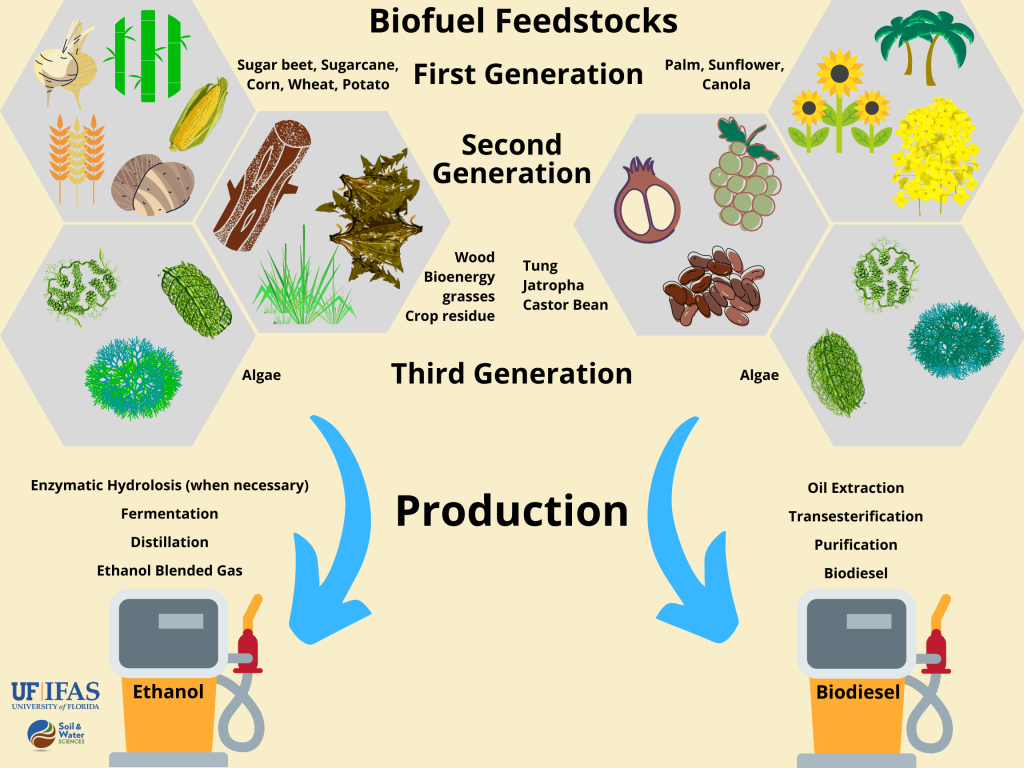For over 100 years, burning fossil fuels has generated most of the energy required to propel our cars, power our businesses, and keep the lights on in our homes. Almost all (95%) of the world’s transportation energy comes from petroleum-based fuels, largely gasoline and diesel. In 2019, oil, coal, and natural gas provided for about 80 percent of U.S. energy needs. Biofuels
However, the burning of fossil fuels for electricity, transportation, heating, and industry is a major contributor to carbon dioxide (CO2) emissions, according to the US EPA. CO2 and other greenhouse gases are the leading cause of climate change. As consumers look for ways to reduce their carbon footprint, many consider biofuels but don’t really know much about them. A new UF/IFAS Extension document from Soil and Water Sciences Department (SWSD) researchers examines the basics of biofuel.
The publication Biofuel: Concepts and Considerations is an introduction to biofuels for Extension educators and the general public. It covers basic terminology, concepts, and impacts of biofuels as a replacement for fossil fuels.
Fossil fuels are non-renewable energy sources that were formed from the fossilized remains of plants and animals that lived millions of years ago. Burning fossil fuels, therefore, releases emissions from ancient stored carbon. In contrast, biofuels are renewable energy sources derived from recently produced biomass, and therefore burning biofuel releases carbon that has only recently been absorbed by the plant material.

Biofuel: Concepts and Considerations
The publication begins with an overview of what biofuel is – both ethanol and biodiesel – and sources of the fuel, or feedstocks. “Most people are familiar with ethanol and biodiesel which are liquid biofuels produced from edible plants, such as corn, sugarcane, and canola,” says Dr. Ann Wilkie, SWSD professor, “but biofuels can be produced from a diversity of feedstocks.”
The publication explains that biofuels can be classified into first-generation, second-generation, and third-generation categories. This is based on the type of feedstock used to produce either ethanol or biodiesel. Most biofuel feedstocks are agricultural products, which raises a food-versus-fuel concern. However, second- and third-generation biofuel production use non-edible biomass feedstocks. Advanced biofuel technologies that use domestic and industrial wastes provide additional benefits in terms of waste management.
The publication discusses the production methods for both biofuel types – fermentation and transesterification for ethanol and biodiesel, respectively. The researchers show the different pathways and general steps producers take to convert the feedstock into a liquid biofuel.
It includes the potential benefit of biofuels as well as other considerations. Biofuels are a renewable energy source and are more environmentally friendly than finite fossil fuels. Biofuel has advantages over petroleum-based fuel provided that biofuel production and consumption do not increase environmental pollution or augment demand for resources like arable land, water, fertilizer, and pesticides. Ultimately, any biofuel production technology needs to be environmentally sustainable and economically profitable.
You can read the full EDIS publication here: https://edis.ifas.ufl.edu/ss688
Featured image at top: Interior of the Stan Mayfield Biorefinery Pilot Plant in Perry, Florida. Credit UF/IFAS Photo by Tyler Jones
 0
0
